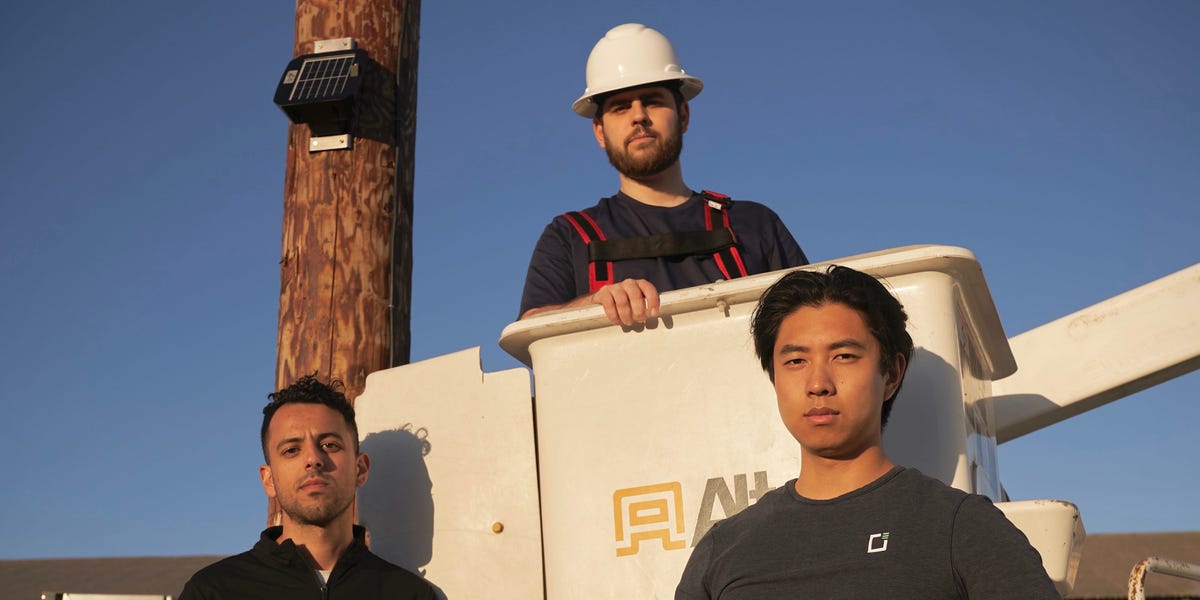- Today’s energy grids are unable to keep up with the intense demand being heaped upon them.
- Startups are working to fix this, and investors are betting that AI and data will play a key role.
- This article is part of “Transforming Business: Infrastructure,” a series exploring the advancements reshaping US infrastructure.
As more cars, stoves, and heating systems are electrified, a lot of strain will be put on decades-old grids in the US and Europe.
In the US, over 70% of transmission lines are over 25 years old, while about 40% of Europe’s distribution grids are over 40. Faulty infrastructure can lead to blackouts, vulnerability to cyberattacks, or other emergencies.
The power system, which was built for gas and coal, is increasingly distributed, with power generated offshore and on roofs. There aren’t enough power lines to connect wind, solar, and geothermal power with households and businesses potentially miles away.
The International Energy Agency has said that to meet the Paris Agreement’s goal of keeping global warming below 1.5 degrees Celsius above preindustrial levels, renewable-energy capacity needs to triple by 2030 and global investment into grids needs to double, to $600 billion a year.
But infrastructure projects are costly and time-consuming. Globally, energy projects struggle to overcome permitting hurdles. Projects finished in the US in 2022 are expected to take five years on average to be connected to the US grid, while projects in the UK have had to wait up to 15 years. Like a motorway at rush hour, lines can become congested and blocked, slowing the flow of power, causing outages, and damaging infrastructure.
Issues are compounded as more electric vehicles and heating systems are plugged into the grid. At the same time, increased domestic manufacturing in the US is expected to cause a surge in demand for energy. Investors told Business Insider that Russia’s war in Ukraine shined a light on energy security and price volatility.
It paints a picture of a fragile system — but investors are optimistic about solutions and are backing startups positioning themselves as such. Many are betting on AI to help optimize existing infrastructure.
“We must leave no stone unturned, both technical and political, to address these challenges,” Rajesh Swaminathan, a partner at Khosla Ventures, a US venture-capital firm, told BI.
Making smart grids a reality
Data was transmitted across a national energy grid for the first time in 2016. People in the industry hailed it as a revolution paving the way for a smarter, automated system that could tweak energy consumption to reduce strain on the grid. The idea is that by better balancing grids, providers can avoid firing up polluting energy sources during peak times or when the sun isn’t shining and the wind isn’t blowing.
But it’s only recently that grid operators were able to know how much capacity is being used in real time or how much electricity is flowing through a cable, said Andrés Dancausa, a partner at the early-stage VC fund TheVentureCity who’s based in Europe.
Operators could use new technology and AI to collect data on voltage, capacity, grid infrastructure, and usage to plan what energy should go where at a certain time, helping avoid congestion and blockages, Dancausa said. This is “something that couldn’t happen a few years ago,” he added.
Swaminathan said the US grid is inefficient because it does a poor job of allocating power where and when it’s needed most. “Instead of overhauling the entire grid, we can address this quickly and easily via AI-powered smart meters installed at the edge,” he said, referring to smart meters at the home or at the point of consumption.
The intersection of energy and AI
Smart meters, which are at the core of some grid digitization strategies, can monitor voltage, grid capacity, and power quality. This data is used to prevent and manage outages and disturbances, to model future supply and demand, and to reroute power when the grid is congested. Some can also track how much energy consumers generate.
The US Department of Energy has earmarked $8.4 million for grid-enhancing technologies, including smart meters.
Startups selling them are hoping to alleviate pressure from physical grid infrastructure and allow operators to do more with the infrastructure they have.
Dancausa pointed to his portfolio company Plexigrid, which has developed a suite of AI software tools to automatically adjust household energy consumption based on usage at a certain time. Bidgely, a startup in Swaminathan’s portfolio, also uses AI to help match energy supply and demand.
Investors told BI that AI could change how consumers pay for and interact with energy.
Victoria McIvor, an advisor to energy startups who was formerly an investor at the European climatetech firm World Fund, imagines a future where energy tariffs dictate when energy-intensive appliances run. “It will be a thing of the past that you put the washing machine on whenever you want,” she said. “Your washing machine will turn on at some point in the day when it makes sense, and you won’t think about it too much.”
“Things in your house will be moving in a smart way according to energy prices,” she added.
Some flexible tariffs and money-back programs that incentivize off-peak energy usage are emerging, such as those run by the UK’s National Grid, OVO, and Octopus Energy.
Infrastructure providers can also use AI to monitor grids.
Enline, a Portuguese startup, uses AI and digital twins, or virtual replicas of real-life assets, for predictive and real-time monitoring of grid infrastructure. The company says its technology allows customers to model and detect energy faults, reduce energy transmission loss, analyze the effects of weather events, and monitor vegetation to prevent it from coming into contact with power lines, which can cause wildfires. Overstory, a startup in Amsterdam, also uses AI and satellite data to monitor vegetation for utility companies to reduce that risk.
Rolling out software and hardware in parallel
VCs prefer investing in software companies that tackle big problems because they can typically scale rapidly at low costs.
But Timothy Barat, the CEO and cofounder of Gridware, said the fear is that relying on software for the grid could lead to postponements of crucial infrastructure builds and upgrades.
“There can’t be any delays,” he said, adding that software-driven boosts wouldn’t be “nearly enough” to hit climate goals in California, where he lives.
AI could help make physical infrastructure builds more efficient, too.
Gridware attaches sensors to transmission-line poles that assess their location 6,000 times a second. It uses AI and machine learning to crunch the data and detect issues to help avoid outages and increase grid resilience. Barat said this, in turn, frees up more resources for building infrastructure.
Generative AI, the tech that powers ChatGPT, is also being applied to the energy industry. Some startups, such as Verse and Reel, say they’re using it to help speed up contracting for projects. Gridcog, a London startup that recently raised $4.2 million from VCs, has developed a platform to model and simulate renewable-energy projects so, say, a supermarket chain can figure out which stores and warehouses are most suitable for solar.
Meanwhile, the Scottish startup Continuum Industries says it has developed an AI platform that lets developers map out power-line routes and analyze infrastructure plans based on their environmental and social impact, engineering requirements, and cost.
Innovating around the grid
Many of these startups sell to utility companies, which can be slow and bureaucratic, investors told BI. This can get in the way of grid upgrades and hobble startup growth, as it can take a long time to secure a deal with utilities and roll out their technology.
Duncan Turner, a general partner at the VC firm SOSV, described it as a difficult pitch for VCs who want to back startups that can scale quickly and widely. “Either governments and utilities are going to figure out how to move quicker, or the private sector will continue to find ways to innovate around the grid,” he said.
Turner said his firm is eying opportunities in long-duration energy storage, such as batteries and hydrogen, to avoid dealing with grids and having to sell to utility companies. Batteries can store clean energy to be used later — when the sun isn’t shining but energy demand is high — and can be sold directly to consumers with their own solar panels.
McIvor said grids used to be relatively simple networks. But today’s systems have sprawling distributed infrastructure with renewable energy and energy storage systems, where power is purchased at cheaper rates and deployed when it would be traditionally more expensive. This makes them “infinitely more complex,” McIvor said.
Software, she added, is at the heart of making sure it works well.
Read the full article here





